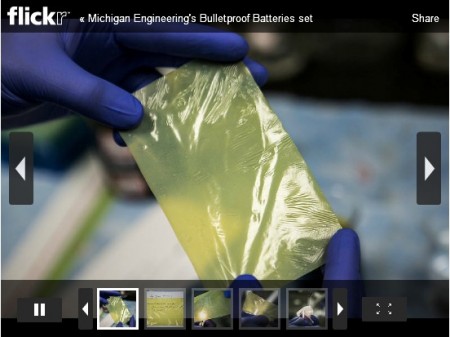Jan
28
A Kevlar Bulletproof Vest for Lithium Ion Batteries
January 28, 2015 | Leave a Comment
University of Michigan (UM) researchers have designed a Kevlar barrier that goes between the anode and cathode electrodes of lithium ion batteries. The new battery technology should be able to prevent the kind of fires that grounded Boeing’s 787 Dreamliners in 2013.
The barrier is made with nanofibers extracted from Kevlar, the tough material in bulletproof vests. The barrier stifles the growth of metal tendrils that can become unwanted pathways for electrical current by removing the conductive path between the electrodes that shorts causing intense sudden heating and the fires.

Kevlar For Lithium Ion Battery Electrode Separator. Click the image to go directly to the Flickr Slideshow. Click here for the link to the Flickr page. Click the Flickr slideshow link at upper right for a full screen slideshow.
Nicholas Kotov, the Joseph B. and Florence V. Cejka Professor of Engineering said, “Unlike other ultra strong materials such as carbon nanotubes, Kevlar is an insulator. This property is perfect for separators that need to prevent shorting between two electrodes.”
Lithium-ion batteries work by lithium ions moving from one electrode to the other. This creates a charge imbalance, and since electrons can’t go through the membrane between the electrodes, they go through a circuit instead and do something useful along the way.
The lithium atoms can build themselves into fern-like structures, called dendrites, which eventually poke through the membrane if the holes in the membrane are too big. When they reach the other electrode, the electrons have a path within the battery, shorting out the circuit. This is how the battery fires on the Boeing 787 are thought to have started.
Siu On Tung, a graduate student in Kotov’s lab, as well as chief technology officer at Elegus explained, “The fern shape is particularly difficult to stop because of its nanoscale tip. It was very important that the fibers formed smaller pores than the tip size.”
While the widths of pores in other membranes in use are a few hundred nanometers, or a few hundred-thousandths of a centimeter, the pores in the membrane developed at UM are 15-to-20 nanometers across. They are large enough to let individual lithium ions pass, but small enough to block the 20-to-50-nanometer tips of the fern-like structures.
The researchers made the membrane by layering the fibers on top of each other in thin sheets. This method keeps the chain-like molecules in the plastic stretched out, which is important for good lithium-ion conductivity between the electrodes, Tung said.
Dan VanderLey, an engineer who helped found Elegus through UM’s Master of Entrepreneurship program said, “The special feature of this material is we can make it very thin, so we can get more energy into the same battery cell size, or we can shrink the cell size. We’ve seen a lot of interest from people looking to make thinner products.”
Kevlar’s heat resistance could also lead to safer batteries as the membrane stands a better chance of surviving a fire than most membranes currently in use.
While the team is satisfied with the membrane’s ability to block the lithium dendrites, they are currently looking for ways to improve the flow of loose lithium ions so that batteries can charge and release their energy more quickly.
While the venture capitalists are looking for a major disruptive technology its quite pleasing to see a very innovative and creative idea offer a beneficial incremental improvement that may well be adopted into consumer products very quickly.

